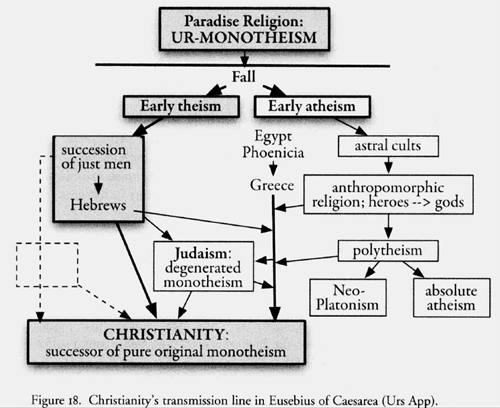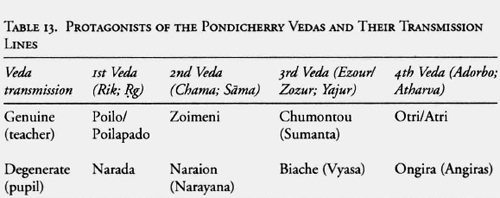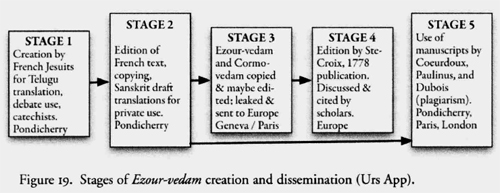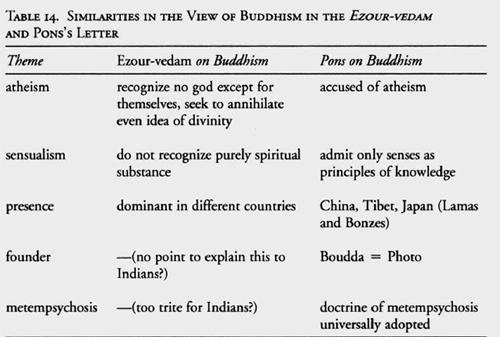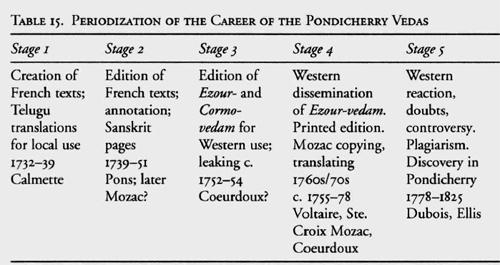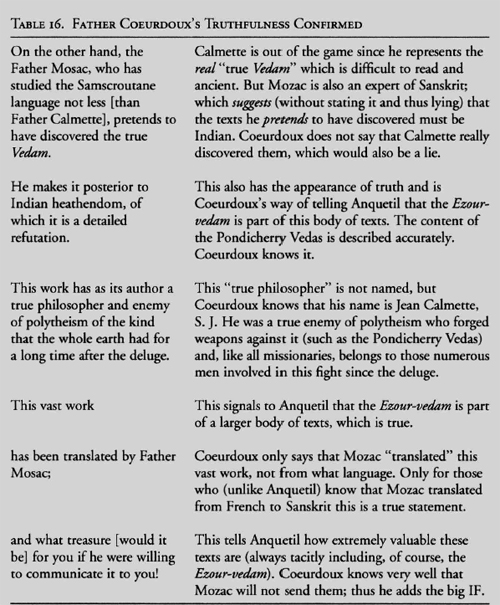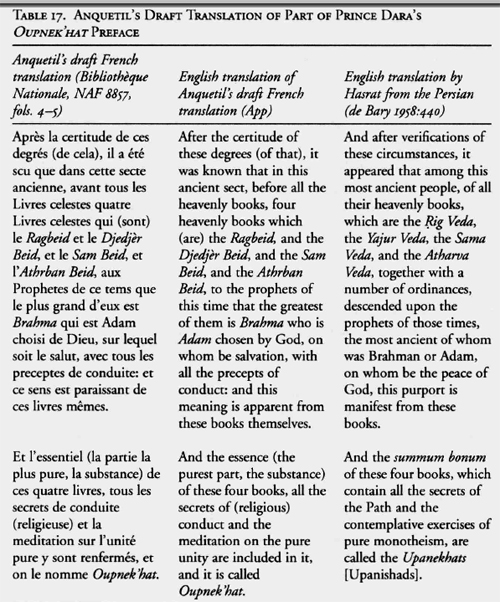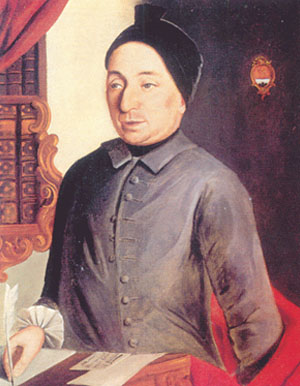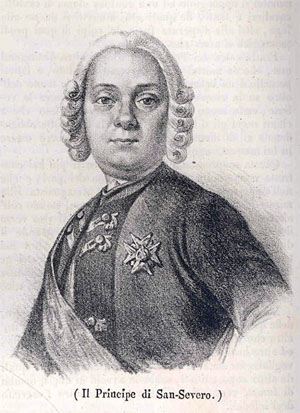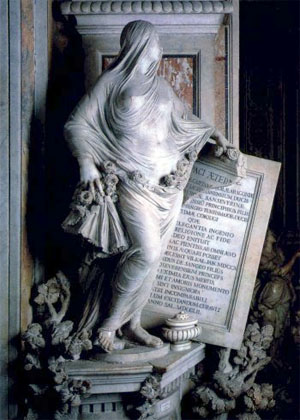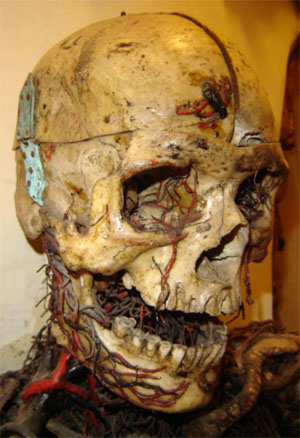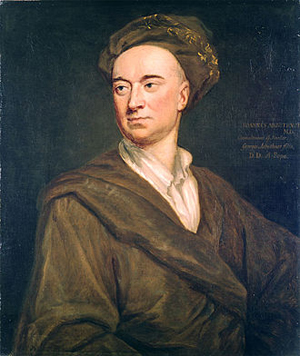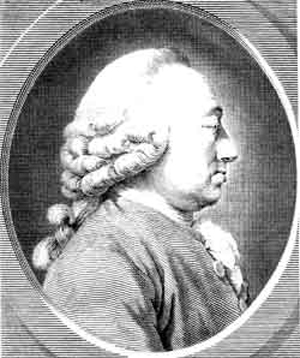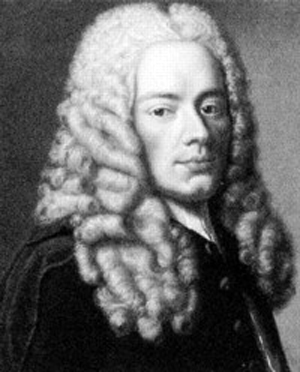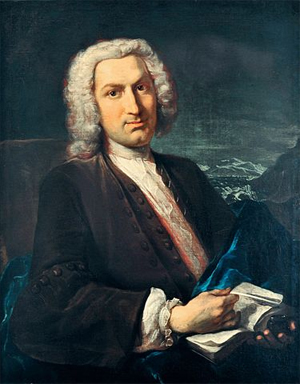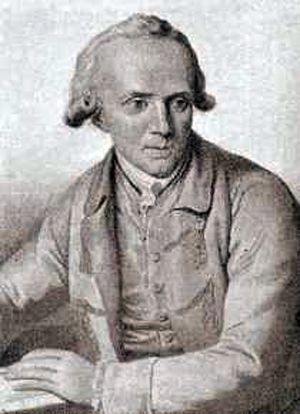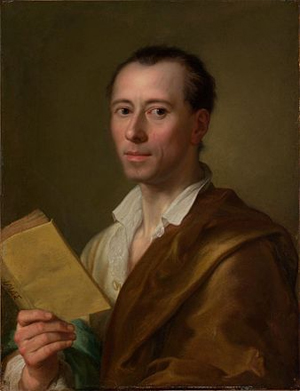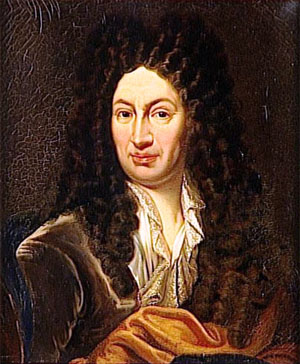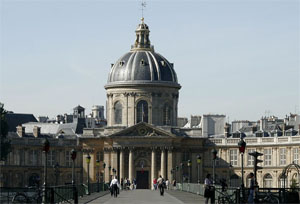by Wikipedia
Accessed: 9/12/20
Le Gac’s doubts about the usefulness of the Vedas he dispatched to Europe were well-founded. Although catalogued, on the basis of the Jesuits’ descriptions of the texts, as soon as 1739, 114 they remained unread throughout the eighteenth century. 115 One of the few who might have been able to read them was the Carmelite Paulinus a Sancto Bartholomaeo. He knew both Sanskrit and the Tamil and Malayalam scripts, and may have recognized Telugu, even if he had not learned it. Paulinus saw them in late 1789, but in the chaos of the revolution was not permitted enough time to examine them closely.116For Paulinus a Sancto Bartholomaeo, the word "Veda" "does not signify exclusively a sacred book but implies in general as much as a sacred law, whether observed by Indians or other nations" (p. 65). Of course, Paulinus famously (and wrongly) argued that "the Vedas" do not exist as a specific set of ancient Indian scriptures and that the Indians call many texts, even non-Indian ones, "Vedas." But modern southern Indian usage agrees with Paulinus's view about the word, as the entries in the University of Madras Tamil Lexicon cited by Rocher(1984:65) show:
vetam: 1. The Vedas; 2. The Jaina scriptures; 3. The Bible; ...
veta-k-karan: Christian (the only meaning!)
veta-pustakam: 1. The Vedas; 2. The Bible.
veta-vakkiyam: 1. Vedic text; 2. Gospel truth.
veta-vakkiyanam: 1. Commentaries on the Vedas; 2. Expounding the bible.
-- The Birth of Orientalism, by Urs AppAnquetil did not limit himself to revealing to us, through his luminous dissertations, what had been the empire of the Achaemenids and the Sassanids, he also introduced us to India, which we did not know in the last century even more than Persia. Voltaire did not take the sanscrit, which was then called Sanscretan, for a book, and was he not duped by the forger who had composed Ezour-Vedam, and surprised the religion of Father Nobili? The Vedas themselves were so ignored that Father Paulinus of Saint-Barthélemy did not believe in their existence, and considered them mythical books. ['Voy. Hem. de l'Acad., t. L, p. 1 and following.]
We can say that the discoveries are in the air and that when they occur, alongside their authors, a crowd of researchers met who had approached them and who would have been called upon to make them, if the discoverer had not been taken from the world before reaching his goal. Thus, at the same time as Anquetil du Perron lifted the veil which hid ancient India from us, Abbé Étienne Mignot, a learned theologian that the Academy had enrolled among its members, shed light in five memoirs published successively by his Collection, the history of Hindu doctrines. [He should not be confused with Father Vincent Mignot, Voltaire's nephew.] An independent mind, who had shaken off the yoke of the Sorbonne, Mignot sometimes succeeded, in spite of very incomplete documents, in unraveling the speculations of these ancient Indian thinkers whose boldness he loved, and which took a century of study to be known and understood.
Anquetil had only been able to advance on the threshold of Hindu literature, with the help of Persian translations; but on the other hand he had collected a prodigious number of information on India and the East, which he put to use and which have earned us works which have remained indispensable to the study of Asia. [its Eastern Legislation and India in relation to Europe.] As his reputation spread, oriental manuscripts and documents from Hindustan and Persia flocked to him in greater numbers; he ended up becoming in Europe the true representative and the literary agent of these countries, which one did not know before with us only by the connections of Bernier, Tavernier, Chardin, merchants or tourist philosophers who had neither the ardor of the French orientalist, nor the taste for erudition. If Anquetil had been able to learn Sanskrit, the last century would already have enjoyed some of the discoveries which have been the exclusive patrimony of ours; but having at its disposal an incomplete vocabulary that had been communicated to him by Cardinal Antonelli, prefect of the Congregation of Propaganda, he tried in vain to translate the Vedas, and had to be content to let us know the Upanishads [We see from a letter from Father Cœurdoux to Anquetil du Perron, which was addressed to him from the Indes in 1771, that the translation of the Vedas was then regarded as an almost impossible undertaking: The true Vedam, writes this missionary, is, in the opinion of Father Calmette, of a Sanserutan (Sanskrit) so old that it is almost unintelligible, and that what is cited is from Vedantam, that is to say introductions and comments made there.]; one of his correspondents had transmitted the text to him in 1775. Thanks to these curious but obscure treatises, Anquetil gave the Academy an idea of the religious philosophy of the Hindus, and he later published a Latin version.[See Handwritten correspondence from Anquetil du Perron, kept at the Imperial Library.]
De Guignes, through another source of information, Chinese documents, sought to shed light on the darkness of the Hindu religion. For want of being able to understand the original books, we were, as we see, reduced to asking the knowledge of Brahmanism and its philosophy from the neighboring peoples of Hindustan, who had only had one idea - perfect; so all the schools and all the sects were confused; we did not even know how to distinguish the Vedic religion from Buddhism; for a long time we had no idea of this latter religion. It was in 1753 that De Guignes read his memoir on the Samaanian philosophers at the Academy, where the first glimpses of knowledge of Buddhism appeared, the teachings of which he had rediscovered in China. However, he associated with the information provided to him by China some indications which he obtained directly from India. He had in his hands the translation of the Bhagavata-Pourana, made on a Tamil version, and due to an indigenous interpreter from Pondicherry, four years later, in 1776, De Gui named Méridas Poullé. He owed it to Minister Bertin, who had given it to him in 1769. De Guignes endeavored to bring out data for the Indian chronology and communicated them in 1772 to his colleagues. But, as was inevitable, this orientalist, who had at his disposal none of the elements suitable to enlighten his progress, without realizing it, a complete shipwreck. Four years later, in 1776, De Guignes named Méridas Poullé. He owed it to Minister Bertin, who had given it to him in 1769. [See, on the Upanichads, Max Muller, A history of ancient Sanskrit literature, 2nd ed., P. 316-319. These books, which are metaphysical commentaries on the Vedas intended for the teaching of young disciples of Brahmam science, belong to the class of writings called Aranyakas, and enjoy the greatest authority in India.] [Under the title of Oupnek'hat, 1802, in-10. See the analysis given by Lanjuinais in his oEuvres, t. 1V, p. 216.]
De Guignes was no happier in his Historical Researches, Indian religion, and on the fundamental books of this religion, published by the Academy. Indeed, without knowledge of Sanskrit, one could only have incomplete and confused notions about India. It was up to England to endow us at last with documents which placed India in its true light. But the dawn of that day was barely breaking when De Guignes was writing his memoirs, and the misfortune for the reputation of this orientalist was to have come too early.
It was only in the last years of the Academy, in 1785, that the works of Ch. Wilkins began to penetrate us. Parraud gave, in 1787, the French translation of the English version of the Indian poem entitled: Bhagavadgîte, that is to say, song of the blessed, epilogue of one of the great Sanskrit epics, the Mahâbhàrata, which A.W. de Schlegel was to make us better known in the following century. An eminent compatriot of Wilkins, William Jones, who had been in India to complete his acquaintance, gave in Calcutta, in 1789, the translation of the famous drama of Kâlidâsa, Sacountala, and published in 1793 the version of Laws of Manu.
-- Histoire de l'Académie des Inscriptions et Belles Lettres (1865), by Louis Ferdinand Alfred Maury
In 1847 the Jesuit Julien Bach commented wryly: “aucun indianiste n’est tenté d’en fair usage, et c’est de ces livres qu’on peut dire: Sacrés ils sont, car personne n’y touche.” [Google translate: No Indianist is tempted to make use of it, and it is from these books that we can say: Sacred they are, because no one touches them.]117It is to these books that Voltaire's mischief could rightly apply:"Sacred they are, because no one touches them."
-- The Father Calmette and the Indianist Missionaries, by Father Julien Bach
-- The Absent Vedas, by Will Sweetman
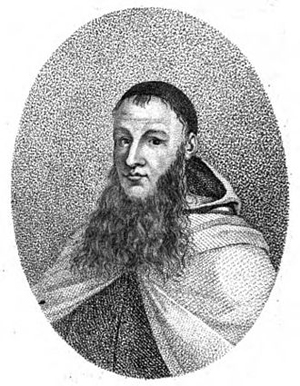
Paulinus of St. Bartholomew
Paulinus of St. Bartholomew (b. at Hof am Leithaberge in Lower Austria, 25 April 1748; d. in Rome, 7 January 1806) was an Austrian Carmelite missionary and Orientalist of Croatian origin[1][2][3][4][5][6][7][8][9][10][11]. He is known by several names as Paulinus S. Bartholomaeo, Paolino da San Bartolomeo, Paulinus Paathiri, Paulin de St Barthelemi, Paulinus A S. Bartholomaeo, Johann Philipp Wesdin, or Johann Philipp Werdin.[12]
He is credited with being the author of the first Sanskrit grammar to be published in Europe,[13] and for being one of the first Orientalists to remark upon the close relationship between Indian and European languages, followed by others such as William Jones and Gaston-Laurent Coeurdoux.[14][15][16]
Life
He was born in a peasant family in Lower Austria, and took the religious habit at the age of twenty. He studied theology and philosophy at Prague. Having entered into the seminary of the missions of his order at Rome, he did Oriental studies at the College of St Pancratius.[17]
He was sent in 1774 as missionary to Malabar, India. After spending fourteen years in India, he was appointed vicar-general of his order and apostolic visitor. He was very well versed in languages: he spoke German, Latin, Greek, Hebrew, Hungarian, Italian, Portuguese, English, Malayalam, Sanskrit, and some other languages of India. He became known in Kerala as Paulinus Paathiri. He was one of the first to detect the similarity between Sanskrit and Indo-European languages, though the very first was likely Fr Thomas Stephens, SJ.
Recalled in 1789 to Rome to give an account of the state of the mission in Indostan, he was charged with editing books -– to correct the Catechisms and elementary books printed at Rome [17] -– for the use of missionaries. On account of political troubles he stayed from 1798 to 1800 at Vienna.
In Rome, he came into contact with Cardinal Stefano Borgia, Secretary of Propaganda Fide, antiquarian scholar and patron, who had set up in Velletri, his native city, the very well-endowed Museo Borgiano. Cardinal Borgia appointed him his private secretary and financed the publication of many volumes of indology, including the first European grammar of the Sanskrit language (Sidharubam seu Grammatica Samscrdamica), published in Rome in 1790. Paulinus also wrote, in Italian, a long essay on India (Viaggio alle Indie Orientali) which was translated into the principal European languages.
In 1800, Pope Pius VII appointed him as counsellor of the Congregation of the Index and as inspector of studies at the Pontifical Urban University. He wrote an account of his travels, translated into French, under the title Voyage aux Index Orientales, published at Paris in 1808.[17]
While in Europe, he also made known the works of Johann Ernst Hanxleden (Arnos Paathiri). He had carried some of Hanxleden's works to Europe. He also wrote about Hanxleden and quotes him extensively in his memoirs.
When Cardinal Borgia died suddenly at Lyons while accompanying Pius VII to Napoleon, Paulinus wrote a moving biography of him.[18][19]
Works
Paulinus wrote many learned books on the East, which were highly valued in their day, among them the first printed Sanskrit grammar. They include:
1. 'Systema brahmanicum liturgicum, mythologicum, civile, ex monumentis indicis musei Borgiani Velitris dissertationibus historico-criticis illustratu (Rome, 1791), translated into German (Gotha, 1797);
2. Examen historico-criticum codicum indicorum bibliothecae S. C. de Propaganda (Rome, 1792);
3. Musei Borgiani Velitris codices manuscripti avences, Peguani, Siamici, Malabarici, Indostani ... illustrati (Rome, 1793);
4. Viaggio alle Indie orientali (Rome, 1796), translated into German by Forster (Berlin, 1798);
5. Sidharubam, seu Grammatica sanscridamica, cui accedit dissert. hiss. crit. in linguam sanscridamicam vulgo Samscret dictam (Rome, 1799), another edition of which appeared under the title "Vyacaranam" (Rome, 1804);
6. India orientalis christiana (Rome, 1794), an important work for the history of missions in India. Other works bear on linguistics and church history.
7. Paolino da San Bartolomeo, Viaggio alle Indie Orientali umiliato alla Santita di N. S. Papa Pio Sesto pontefice massimo da fra Paolino da S. Bartolomeo carmelitano scalzo, Roma, presso Antonio Fulgoni, 1796.
8. Paolino da San Bartolomeo, Voyage aux Indes Orientales, par le p. Paulin de S. Barthelemy, missionnaire; traduit de l'italien ... avec les observations de Mm. Anquetil du Perron, J. R. Forster et Silvestre de Sacy; et une dissertation de M. Anquetil sur la proprieté (in lingua francese), A Paris, chez Tourneisen fils, libraire, rue de Seine, n 12, 1808.
9. Paulinus a S. Bartholomaeo, Amarasinha. Sectio prima de caelo ex tribus ineditis codicibus indicis manuscriptis curante P. Paulino a S. Bartholomaeo ... (in lingua Latina), Romae, apud Antonium Fulgonium, 1798.
10. Paulinus von Heilig Bartholomaus, Atlas pour servir au voyage aux Indes orientales. Par le p. Paulin de Saint-Barthelemy, missionaire (in lingua francese), A Paris, chez Tourneisen fils, 1808.
11. Paulinus a S. Bartholomaeo. De basilica S. Pancratii M. Christi disquisitio. Auctore P. Paulino a S. Bartholomaeo (in lingua Latina), Romae, apud Antonium Fulgonium, 1803.
12. Paulinus a S. Bartholomaeo, Dissertation on the Sanskrit language, Paulinus a S. Bartholomaeo (in lingua inglese), a reprint of the original Latin text of 1790, together with an introductory article, a complete English translation, and an index of sources by Ludo Rocher, Amsterdam, J. Benjamin, 1977.
13. Paulinus a S. Bartholomaeo, Examen historico criticum codicum indicorum bibliothecae Sacrae Congregationis de propaganda fide (in lingua Latina), Romae, ex typ. S. C. de Propaganda Fide, 1792.
14. Paulinus a S. Bartholomaeo, India orientalis christiana continens fundationes ecclesiarum, seriem episcoporum, Auctore P. Paulino a S. Bartholomaeo carmelita discalceato (in lingua Latina), Romae, typis Salomonianis, 1794.
15. Paulinus a S. Bartholomaeo, Jornandis vindiciae de Var Hunnorum auctore p. Paulino a S. Bartolomeo carmelita discalceato ... (in lingua Latina), Romae, Apud Antonium Fulgonium, 1800.
16. Paolino da San Bartolomeo, Monumenti indici del Museo Naniano illustrati dal P. Paolino da S. Bartolomeo (in lingua Latina), In Padova, nella Stamperia del Seminario, 1799.
17. Paulinus a S. Bartholomaeo, Mumiographia Musei Obiciani exarata a P. Paulino a S.Bartholomaeo carmelita discalceato (in lingua Latina), Patavii, ex Typographia Seminarii, 1799.
18. Paulinus a S. Bartholomaeo, Musei Borgiani Velitris codices manuscripti Avenses Peguani Siamici Malabarici Indostani animadversionibus historico-criticis castigati et illustrati accedunt monumenta inedita, et cosmogonia Indico-Tibetana, auctore p. Paulino a S. Bartholomaeo ... (in lingua Latina), Romae, apud Antonium FUgonium, 1793.
19. Paulinus a S. Bartholomaeo, Sidharubam seu Grammatica Samscrdamica. Siddarupam. Cui accedit Dissertatio historico-critica in linguam Samscrdamicam vulgo Samscret dictam, in qua huius linguae exsistentia, origo, praestantia, antiquitas, extensio, maternitas ostenditur, libri aliqui ea exarati critice recensentur, & simul aliquae antiquissimae gentilium orationes liturgicae paucis attinguntur, & explicantur auctore Fr. Paulino a S. Bartholomaeo ... (in lingua Latina), Romae, ex typographia Sacrae Congregationis de Propaganda Fide, 1790.
20. Paulinus a S. Bartholomaeo, Systema Brahmanicum liturgicum mythologicum civile ex monumentis Indicis musei Borgiani Velitris dissertationibus historico-criticis illustravit fr. Paullinus a S. Bartholomaeo carmelita discalceatus Malabariae missionarius Academiae Volscorum Veliternae socius (in lingua Latina), Romae, apud Antonium Fulgonium, 1791.
21. Paulinus a S. Bartholomaeo, Vitae synopsis Stephani Borgiae S.R.E. cardinalis amplissimi S. Congr. De Propaganda fide praefecti curante p. Paulino a S. Bartholomaeo carmelita discalceato ... (in lingua Latina), Romae, apud Antonium Fulgonium, 1805.
22. Paulinus a S. Bartholomaeo, Vyacarana seu Locupletissima Samscrdamicae linguae institutio in usum Fidei praeconum in India Orientali, et virorum litteratorum in Europa adornata a P. Paulino a S. Bartholomaeo Carmelita discalceato (in lingua Latina), Romae, typis S. Congreg. de Propag. Fide, 1804.
23. Paulinus a S. Bartholomaeo, Notitia topographica, civilis, politica, religiosa missionis Malabaricae ad finem saeculi 18. / auctore r. P. Paulino a S. Bartholomaeo, O. C. D. (in lingua Latina), Romae, apud Curiam generalitiam, 1937, Tip. A. Manuzio.
24. Paulinus of St. Bartholomew: De manuscriptis codicibus indicis R. P. Joan Ernesti Hanxleden epistola ad. R. P. Alexium Mariam A. S. Joseph Carmelitam excalceatum, Vienna, 1799.
English Translation by Google translate
1. 'The liturgical, mythological, and civil Brahmanical system, illustrated by the historico-critical dissertations of the Borgiani Velitris museum (Rome, 1791), translated into German (Gotha, 1797);
2. A historical-critical examination of the Indian codices of the S. C. de Propaganda library (Rome, 1792);
3. Musei Borgiani Velitris manuscript manuscripts, Peguani, Siamese, Malabaric, Indostani ... illustrated (Rome, 1793);
4. Viaggio alle Indie orientali (Rome, 1796), translated into German by Forster (Berlin, 1798);
5. The Sidharubam, or Sanskrit Grammar, which he approaches and discusses. hiss crit. in the Sanskrit language commonly called Samscret (Rome, 1799), another edition of which appeared under the title "Vyacaranam" (Rome, 1804);
6. India orientalis christiana (Rome, 1794), an important work for the history of missions in India. Other works bear on linguistics and church history.
7. Paolino da San Bartolomeo, Journey to the East Indies humiliated at the Holiness of Our Lord Pope Pius the Sixth Pontiff Maximus by Fra Paolino da S. Bartolomeo the barefoot Carmelite, Rome, near Antonio Fulgoni, 1796.
8. Paolino da San Bartolomeo, Journey to the East Indies, by Fr. Paulinus of St. Barthelemy, missionary; translated from the Italian ... with the observations of Mms. Anquetil du Perron, J. R. Forster and Silvestre de Sacy; and a dissertation by Mr. Anquetil on property (in lingua francese), In Paris, chez Tourneisen fils, bookseller, rue de Seine, n 12, 1808.
9. Paulinus from S. Bartholomew, Amarasinha. The first section on heaven from three unpublished codices indicia manuscripts under the care of P. Paulinus a S. Bartholomaeus ... (in the Latin language), Rome, at Antonius Fulgonius, 1798.
10. Paulinus von Heilig Bartholomaus, Atlas to be used for travel to the East Indies. By Fr. Paulin de Saint-Barthelemy, missionary (in French), In Paris, at Tourneisen fils, 1808.
11. Paulinus from St. Bartholomew. A discussion of the basilica of St. Pancratius M. Christi. By P. Paulinus from S. Bartholomew (in the Latin language), Rome, at Antonius Fulgonius, 1803.
12. Paulinus a S. Bartholomaeo, Dissertation on the Sanskrit language, Paulinus a S. Bartholomaeo (in lingua inglese), a reprint of the original Latin text of 1790, together with an introductory article, a complete English translation, and an index of sources by Ludo Rocher, Amsterdam, J. Benjamin, 1977.
13. Paulinus a S. Bartholomaeus, A historical critical examination of the Indian codices of the library of the Sacred Congregation on the propagation of faith (in the Latin language), Rome, ex typ. S. C. on the Propagation of the Faith, 1792.
14. Paulinus a S. Bartholomaeus, Christian Eastern India containing the foundations of the churches, a series of bishops, by P. Paulinus a S. Bartholomeus a Carmelite Discalced (in the Latin language), Rome, Solomonian type, 1794.
15. Paulinus from St. Bartholomew, author of Jornand's revenge on Var Hunnorum p. Paulinus by St. Bartholomew the Carmelite ... (in the Latin language), Rome, Apud Antonium Fulgonium, 1800.
16. Paolino da San Bartolomeo, Index monuments of the Naniano Museum illustrated by P. Paolino da S. Bartolomeo (in Latin language), In Padua, in the Seminary Printing House, 1799
17. Paulinus a S. Bartholomaeus, Mumiographia Musei Obiciani engraved by P. Paulinus a S.Bartholomaeus carmelita discalceato (in the Latin language), Patavi, from Typographia Seminarii, 1799.
18. Paulinus a S. Bartholomaeus, Musei Borgiani Velitris manuscript manuscripts Avenses Peguani Siamici Malabarici Indostani chastened and illustrated with historical-critical remarks add unpublished monuments, and Indo-Tibetan cosmogony, author p. Paulinus by S. Bartholomew ... (in the Latin language), Rome, at Antonius Fugonius, 1793.
19. Paulinus from St. Bartholomew, Sidharuba or Grammatica Samscrdamica. Siddarupam To which is added a historical-critical Dissertation on the Samskrdamic language commonly called Samskret, in which the existence, origin, importance, antiquity, extension, and motherhood of this language are shown, some books written by it are critically reviewed, and at the same time some of the most ancient liturgical prayers of the Gentiles are touched upon and explained by the author Fr. Paulinus by S. Bartholomew ... (in the Latin language), Rome, from the printing of the Sacred Congregation for the Propaganda of the Faith, 1790.
20. Paulinus from St. Bartholomew, the Brahmanic liturgical mythological civil system from the Indian monuments of the Borgian Velitris museum illustrated by historical-critical dissertations fr. Paullinus a Discalced Carmelite of St. Bartholomew, missionary of Malabaria, member of the Veliterna Academy of the Volscorum (in the Latin language), Rome, under Antonius Fulgonius, 1791.
21. Paulinus a S. Bartholomew, Synopsis of the Life of Stephen Borgia S.R.E. the cardinal of the great St. Congr. On the Propaganda of the faith of the presiding officer, p. Paulinus a S. Bartholomaeus carmelita discalceato ... (in the Latin language), Rome, at Antonius Fulgonium, 1805.
22. Paulinus by St. Bartholomew, Vyacarana or the Richest Samscrdamic Language Instruction for the Use of the Heralds of the Faith in Eastern India, and Men of Letters in Europe Adorned by P. Paulinus by St. Bartholomew the Discalced Carmelite (in Latin), Rome, Type of St. Congregation of Propag. Faith, 1804
23. Paulinus from S. Bartholomew, Notitia topographica, civil, political, religious mission Malabarica at the end of the 18th century. / author r. P. Paulinus a S. Bartholomaeus, O. C. D. (in the Latin language), Rome, at the General Court, 1937, Tip. A. Manuzio
24. Paulinus of St. Bartholomew: De manuscriptis codices indicas R. P. Joan Ernesti Hanxleden letter to R. P. Alexius Mariam A. S. Joseph Carmelite Exalted, Vienna, 1799.
Notes
1. "sanskrt - Hrvatska enciklopedija". Retrieved 4 July 2017.
2. "Vesdin, Filip Ivan - Hrvatska enciklopedija". Retrieved 4 July2017.
3. "Hrvatski "indolog" Ivan Filip Vesdin (1748-1806) i "Portugalske Indije"". Retrieved 4 July 2017.
4. "Religious Studies: A Global View". Retrieved 4 July 2017.
5. "Filip Vezdin - Croatian History". Retrieved 4 July 2017.
6. "Filip Vezdin bio je gradišćanski Hrvat". Archived from the original on 8 May 2016. Retrieved 4 July 2017.
7. "Vatroslav Jagić (1865.) o Filipu Vezdinu ( 1748.-1806.) - Hrvatske novine". Retrieved 4 July 2017.
8. "indoeuropski jezici - Proleksis enciklopedija". Retrieved 4 July 2017.
9. "Vezdin - značenje - Hrvatski leksikon". Retrieved 4 July2017.
10. "H. Kekez: Velikani hrvatske prošlosti by Svijet Knjige - issuu". Retrieved 4 July 2017.
11. "Johann Philipp Vezdin - Paulinus a Sancto Bartholomaeo". Retrieved 4 July 2017.
12. Paulinus a S. Bartholomaeo, Paolino da San Bartolomeo; known as Paulinus Paathiri; secular name Johann Philipp Wesdin.
13. "PAULINUS A SANCTO BARTHOLOMAEO, [Johannes Philippus Werdin or Wesdin].India Orientalis Christiana continens fundationes ecclesiarum, seriem episcoporum, missiones, schismata, persecutiones, reges, viros illustres". Horden House. Archived from the original on 25 January 2013. Retrieved 13 February 2012. Paulinus a S. Bartholomaeo (1748-1806).....He was the author of many learned studies on the east, and published the first Sanskrit grammar
14. "Sidharubam seu grammatica Samscrdamica cui accedit dissertatio historico-critica in languam samscrdamicam vulgo samscret dictam by Paulinus a S. Bartholomaeo". National Book Auctions.com. Retrieved 12 February 2012. First Edition - This is a scarce first edition of the first Sanskrit grammar to be published in Europe.
15. "Results from NBA's January Auction". finebooksmagazine.com. Retrieved 12 February 2012. Philip Werdin (or Wesdin) was an Austrian Carmelite missionary in Malabar from 1776 to 1789. An outstanding Orientalist, he was one of the first to remark upon the close relationship between Indian and European languages
16. "British Library - Mss Eur K153 - PAULINUS, a Sancto Bartholomaeo". bl.uk. Retrieved 13 February 2012. A copy of `Systema Brahmanicam' (Rome 1791) by Fr Paolino (Paulinus, a Sancto Bartholomaeo [Joannes Philippus Werdin or Wesdin]), containing critical comments possibly by Sir William Jones (1746-94), oriental scholar, Judge of Supreme Court, Calcutta 1783-94
17. Gorton, John (1833). A General Biographical Dictionary. Whittaker and Co. Retrieved 12 February 2012.
18. Vitae synopsis Stephani Borgiae S.R.E. cardinalis amplissimi S. Congr. De Propaganda fide praefecti curante p. Paulino a S. Bartholomaeo carmelita discalceato. Romae, apud Antonium Fulgonium, 1805
19. Carlo Gastone della Torre di Rezzonico, Lettera su' monumenti indici del Museo Borgiano illustrati dal padre Paolino di San Bartolomeo in Opere del cavaliere Carlo Castone conte Della Torre di Rezzonico patrizio comasco raccolte e pubblicate dal professore Francesco Mocchetti, Como, presso lo stampatore provinciale Carlantonio Ostinelli, 1820, Tomo VIII, p. 7-54
English Translation by Google translate
1. "Sanskrit - Croatian encyclopedia". Retrieved 4 July 2017.
2. "Vesdin, Filip Ivan - Croatian encyclopedia". Retrieved 4 July 2017.
3. "Croatian "Indologist" Ivan Filip Vesdin (1748-1806) and the "Portuguese Indies"". Retrieved 4 July 2017.
4. "Religious Studies: A Global View". Retrieved 4 July 2017.
5. "Filip Vezdin - Croatian History". Retrieved 4 July 2017.
6. "Filip Vezdin was a Croat from Gradišće". Archived from the original on 8 May 2016. Retrieved 4 July 2017.
7. "Vatroslav Jagić (1865) about Filip Vezdin (1748-1806) - Croatian newspapers". Retrieved 4 July 2017.
8. "Indo-European languages - Prolexis encyclopedia". Retrieved 4 July 2017.
9. "Vezdin - meaning - Croatian lexicon". Retrieved 4 July 2017.
10. "H. Kekez: Giants of the Croatian past by Svijet Knjije - issuu". Retrieved 4 July 2017.
11. "Johann Philipp Vezdin - Paulinus a Sancto Bartholomaeo". Retrieved 4 July 2017.
12. Paulinus a S. Bartholomaeo, Paolino da San Bartolomeo; known as Paulinus Paathiri; secular name Johann Philipp Wesdin.
13. "PAULINUS A SANCTO BARTHOLOMAEO, [Johannes Philippus Werdin or Wesdin].India Orientalis Christiana continens fundationes ecclesiarum, seriem episcoporum, missiones, schismata, persecutiones, reges, viros illustres". Horden House. Archived from the original on 25 January 2013. Retrieved 13 February 2012. Paulinus a S. Bartholomaeo (1748-1806).....He was the author of many learned studies on the east, and published the first Sanskrit grammar
14. "Sidharubam seu grammatica Samscrdamica cui accedit dissertatio historico-critica in languam samscrdamicam vulgo samscret dictam by Paulinus a S. Bartholomaeo". National Book Auctions.com. Retrieved 12 February 2012. First Edition - This is a scarce first edition of the first Sanskrit grammar to be published in Europe.
15. "Results from NBA's January Auction". finebooksmagazine.com. Retrieved 12 February 2012. Philip Werdin (or Wesdin) was an Austrian Carmelite missionary in Malabar from 1776 to 1789. An outstanding Orientalist, he was one of the first to remark upon the close relationship between Indian and European languages
16. "British Library - Mss Eur K153 - PAULINUS, a Sancto Bartholomaeo". bl.uk. Retrieved 13 February 2012. A copy of `Systema Brahmanicam' (Rome 1791) by Fr Paolino (Paulinus, a Sancto Bartholomaeo [Joannes Philippus Werdin or Wesdin]), containing critical comments possibly by Sir William Jones (1746-94), oriental scholar, Judge of Supreme Court, Calcutta 1783-94
17. Gorton, John (1833). A General Biographical Dictionary. Whittaker and Co. Retrieved 12 February 2012.
18. Vitae synopsis Stephani Borgiae S.R.E. cardinalis amplissimi S. Congr. De Propaganda fide praefecti curante p. Paulino a S. Bartholomaeo carmelita discalceato. Romae, apud Antonium Fulgonium, 1805
19. Carlo Gastone della Torre di Rezzonico, Lettera su' monumenti indici del Museo Borgiano illustrati dal padre Paolino di San Bartolomeo in Opere del cavaliere Carlo Castone conte Della Torre di Rezzonico patrizio comasco raccolte e pubblicate dal professore Francesco Mocchetti, Como, presso lo stampatore provinciale Carlantonio Ostinelli, 1820, Tomo VIII, p. 7-54
References
• This article incorporates text from a publication now in the public domain: Herbermann, Charles, ed. (1913). "Paulinus a S. Bartholomaeo". Catholic Encyclopedia. New York: Robert Appleton Company. The entry cites:
o Giuseppe Barone, Vita, precursori ed opere del P. Paolino da S. Bartolommeo (Filippo Werdin) : contributo alla storia degli studi orientali in Europa (Napoli: A. Morano, 1888);
o Max von Heimbucher, Die Orden und Kongregationen der katholischen Kirche, II (2nd ed., Paderborn: Schoningh, 1907), 568-69
• Memoirs on various antiquities of Persia: and on the medals of the kings of the Sassanid dynasty; followed by the history of this dynasty (1793)
• Principles of general grammar: placed within the reach of children, and suitable to serve as an introduction to the study of all languages (1799)
• Memoir on various events in the history of the Arabs before Mohammed (1803)
• Arab Chrestomathie, or, Extracts from various Arab writers, both in prose and in verse, with a French translation and notes, for the use of students of the Royal and Special School of Modern Oriental Languages (1806)
• Specimen historiae arabum by Bar Hebraeus (1806)
• Memoir on the Assassin dynasty and the origin of their name (1809)
• Arabic grammar for the use of students of the Special School of Modern Oriental Languages (1810)
• Hariri's sessions, published in Arabic with a commentary chosen by Ḥarīrī (1822)
• Arabic grammatical anthology: or, Selected pieces from various Arab grammarians and scholiasts, with a French translation and notes; possibly following the Arab Chrestomathy (1829)
• Arabic grammar for the use of students at the Special School of Modern Oriental Languages (1831)
• Presentation of the religion of the Druze, taken from the religious books of this sect, and preceded by an introduction and the Life of the Caliph Hakem-biamr-Allah (1838)
• The thousand and One Nights; Arab tales (1839)
• Library of Baron Silvestre de Sacy (1846)
• Miscellanies of oriental literature (1861)
External links
• Paulinus of St. Bartholomew
• PAULINUS A S. BARTHOLOMAEO (WERDIN, JOHANN PHILIP)[permanent dead link]
• Catholic Missionaries - John Philip Werdin

